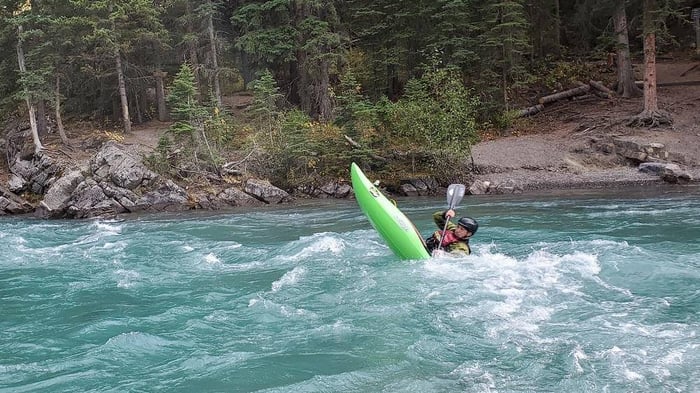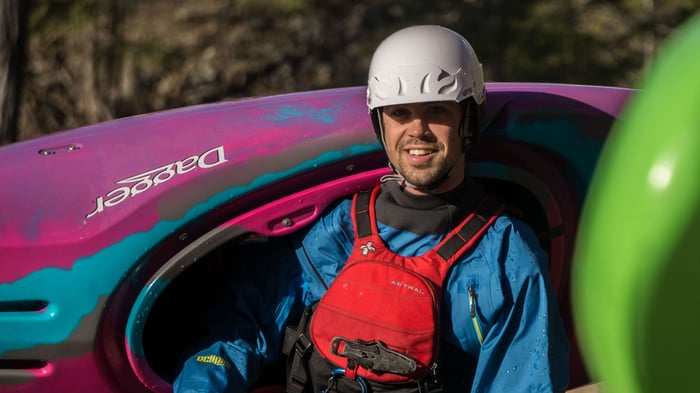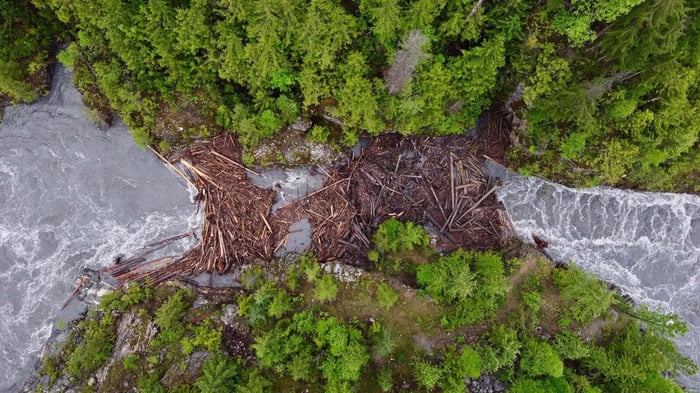Whitewater kayaking looks fun and you want to know where to start.
Maybe you’ve whitewater rafted, paddled across lakes and want something more exciting, or saw a cool article in a magazine.
Whitewater kayaking is a broad sport. There are many categories and styles. They range from slow moving rivers to the extreme whitewater kayaking you see in Red Bull movies.
No matter which style you end up doing, whitewater kayaking is a super fun and unique sport. Nothing puts you in an environment as dynamic as whitewater. The feeling of being swept down a river, bouncing through currents and splashing through wave trains, is natural and addictive.
The river is wild and untapped. Even as a whitewater kayaking beginner you'll experience this feeling.
Regardless of where whitewater kayaking takes you, there’s fundamental information every beginner needs to know.
In this article we’ll give you an overview of the sport, what kind of gear you need, and where to start. We’ll end with words of wisdom and your next steps.
Beginner Whitewater Kayaking
What is Whitewater

Splashing through waves never gets old.
Photo: Courtesy of Jackson Kayaks
Whitewater is any section of river that is either fast, steep, or narrow enough to produce rapids. These can be small brief rapids formed around small boulders, or extended sections of extreme whitewater that require complicated moves .
In this article we’ll focus on rivers with short, mild rapids suitable for whitewater kayaking beginners. As you progress you can step up to longer and more complex rapids.
Whitewater is rated from Class 1-5.

Class 1
Class 1 is slow moving water with little to no rapids. Class 1 is suitable for practicing fundamental skills and casual floats.

Class 2
Photo: Courtesy of Jackson Kayaks
Class 2 are smaller, shorter rapids. These often require only one or two moves to negotiate. Many are tame enough that you can simply paddle through them. This is where you'll spend most of your time learning whitewater kayaking.

Class 3
Photo: Courtesy of Jackson Kayaks
Class 3 involves bigger and more sustained rapids. This where moves become necessary. The water is faster and everything happens quickly. You start seeing classic wave trains and small boulder gardens. They're a ton of fun and relatively consequence free. Consequences are usually no more than a brief 30 second swim, into either a comfortable eddy by shore or calmer water downstream of the rapids.
This level of river is where many whitewater kayakers will progress to and be content with. These types of rivers are still exciting and provide a challenge. They’re also the type of river where many great surf waves are found.

Class 4 represents a big step up from Class 3. Technical skills are required and you must make consecutive complex maneuvers on longer sections of whitewater. This is where you face more serious consequences if you swim out of your kayak: extended time in the water and potentially having to swim through whitewater features.
This class of river is a significant jump in challenge and should only be attempted by the advanced whitewater kayaker.
 Class 5
Class 5
Photo: Courtesy of Jackson Kayaks
Class 5 represents serious reward, and risk, to anyone whitewater kayaking. Experts only. With the right skills this level of whitewater is extremely rewarding, as the payoff for taking risks leads to an amazing sense of accomplishment. Class 5 should only be attempted by highly qualified kayakers as the consequences of a swim are serious.
That’s a basic outline of whitewater and how rapids are categorized.
It’s also important to know there are many disciplines in whitewater kayaking. You can choose to casually run rivers, surf waves and do freestyle, or try steep technical “creeks” which require their own specific set of skills. There is also slalom kayaking, which is an Olympic sport.
These disciplines will be covered in a future article.
Whitewater kayaking is a broad sport. There are not only many different kinds of rivers, but different disciplines within the sport itself.
Learning fundamentals is the first step, what you do from there is up to you.
Choosing a Beginner Whitewater Kayak

A modern river running whitewater kayak: stable, easy to control, and surfable.
Photo: Courtesy of Jackson Kayaks. A Zen 3.0 is pictured here. The Zen is one of the best beginner whitewater kayaks.
There are many types of whitewater kayaks. They range from freestyle, to river runners, to creek boats.
This is a mini whitewater kayak buying guide
Avoid buying a cheap Canadian Tire Pelican, or similar kayak from a big box store, and thinking it’ll work for whitewater kayaking.
Those boats are low quality and aren’t designed for performance on whitewater. If you show up to the river with one of them, expect to have a long and frustrating day.
Buying a proper, quality, purpose built whitewater kayak will enable you to actually maneuver on the river and will provide a far better experience.
For beginner whitewater kayaking, “river runners” are the ideal category of kayak to start with. They strike the best balance between maneuverability, performance, and ease of use for a beginner. One of the best rated boats in this category is the Jackson Zen 3.0, featured in the above image.
For other options, checkout this collection.
Even advanced kayakers will us these boats for whitewater kayaking.
They are great all-around performers, and you can surf them. When you see kayakers surfing your local waves you will definitely want to get in on the action.
This type of boat is also in high demand, so if you choose to buy a different style of kayak after your skills develop, a river running kayak will be relatively easier to sell.
The other two major whitewater kayak types are freestyle and creek.
Freestyle kayaks are short and stubby. They are designed for flips and spins. They are also extremely unstable and will be frustrating for whitewater kayaking beginners. But, if you are fit and prefer trial by fire, nothing will teach you edge control better than these kayaks.
Creek kayaks are designed for Class 4/5 water. They are unforgiving for beginners because they require aggressive, skillful paddling to maneuver. They are large, long, and heavy. It is a lot of work to move these kayaks around a river.
Choosing Whitewater Kayaking Gear

Whitewater kayaking gear essentials: Kayak, Paddle, Helmet, PFD, Spray Deck
Photo: Courtesy of Jackson Kayaks
There are a ton of gear choices for whitewater kayaking. The options can be overwhelming and it is tough to figure out exactly what you need, especially if you are on a budget.
Checkout this video for a basic outline of this topic.
For a thorough list, and prices, checkout the Beginners Guide to Whitewater Kayaking Gear article.
The basics are a whitewater kayak, helmet, paddle, PFD (with whistle and knife), and spray deck.
Extras include warm layers like a wetsuit, a dry top or dry suit (men's or women's), float bags, throw bag, and a dry bag.
For whitewater kayaking, quality matters. Well performing, well fitting gear makes a huge difference to your experience of the sport.
If you are paddling in areas with colder water, investing in a dry top and proper layers will increase your comfort level, keep you warmer, and enable you to spend more time whitewater kayaking.
As a beginner you'll likely find yourself swimming. The warmer you can stay the better your days will be. If there’s bad weather during your intro course you’ll spend less time trying to warm up on shore and more time in your boat.
How To Learn Whitewater Kayaking

A typical intro course: fundamentals on simple moving water. Also a great place to meet new people and find paddling buddies.
Whitewater kayaking is not something you want to learn on your own.
Your lack of safety and river awareness are two big reasons why it’s important to learn with others.
Swiftwater Rescue is a discipline unto itself. Only by going out with experienced, and trained, kayakers will you have the help you need if you do find yourself in trouble.
It is also important to go out with people who know the river. There are many things to watch out for as whitewater kayaking beginner.
These can be simple like where to get in and out of a river, or more complicated like reading the river and knowing how to spot tricky rapids.
AQ Outdoors offers industry leading whitewater kayaking courses, programs, and safety training.
Many outdoor centers and local clubs offer similar courses.
Finding a Group to Kayak With

Kayaking is not a solo sport. Finding the right people to kayak with is important.
After learning basic skills, the next step is finding a whitewater kayaking group. Maybe you took the course with some friends. Or maybe you took the course with a local club. In that case, you have probably already found people to paddle with.
If you haven’t, your best option is to research local clubs or Facebook Groups. Many will have options for beginner river runs.
A couple notes about whitewater kayaking etiquette.
Be honest about your skills. Let them know what Class of whitewater you are comfortable on. If you are struggling with certain skills, like catching eddies, let your trip leader know. This way they’ll keep a closer eye on you and be prepared to help.
When you do find a group, show up on time with all your gear organized. The better first impression you give your fellow kayakers, the greater chances you’ll be invited out again.
If you are with a club, help unload gear. This will put you in their good books.
Triple check your gear before you leave your home. Make a list of everything you need.
As you adventure on more rivers you’ll meet plenty of new people. Whitewater kayaking is a close knit community and people are open and friendly.
Don’t be surprised if you end up forming lifelong friendships with the people you meet.
Progressing in the Sport

New skills on a challenging line get everyone stoked!
There are many paths through whitewater kayaking. Maybe you end up being content on Class 3. That’s perfectly ok. Many paddlers are happy on this level of whitewater. It’s fun and relatively risk free. You don’t need to be on extreme whitewater to have fun, and you don’t need to prove anything.
If you decide to step up your game, make sure you are with a group you can trust. Attempting difficult whitewater can be stressful so it helps if you are with patient kayakers.
Progressing to more difficult water can be a head game. For more information check out this article: How to Scout Rapids for Whitewater Paddlers.
You can also take courses for more advanced whitewater.
Maybe you want to try freestyle, or slalom kayaking?
Search for slalom clubs and courses in your local area.
Research the best surf waves and holes in your area. Figure out the best flows then reach out to other boaters when the levels are prime. Use PaddlingMaps.com to research local rivers and plan road trips.
Don’t be afraid to try new things. And never forget to work on fundamentals. The core skills you learn as a whitewater kayak beginner are important no matter which path you find yourself on. Even Olympic kayakers spend considerable time working on basic skills.
Always look to improve and increase your efficiency. If you get lazy the river will let you know.
Your Intro to Whitewater Kayaking

Nothing beats the freedom of a kayak and whitewater.
Photo: Courtesy of Jackson Kayaks
Whitewater kayaking is a fun, dynamic sport. The people are close and there's always an opportunity to try out new things.
The sport is whatever you want it to be: casual floats or extreme waterfalls; bobbing down rapids or surfing waves; weaving through slalom gates or gliding around boulder gardens.
Take this advice as your starting point and get out there! Check the AQ Outdoors Blog regularly for more updates about everything whitewater kayaking!
Other Whitewater Kayaking Posts
About the Authour: Dan used to instruct for AQ Outdoors and spent his 20s chasing whitewater up and down the Rockies and across Western Canada. He can still be found surfing local waves, trying to get some old moves back. If you are a mountain biker checkout his site Hardtail Canada.






















































